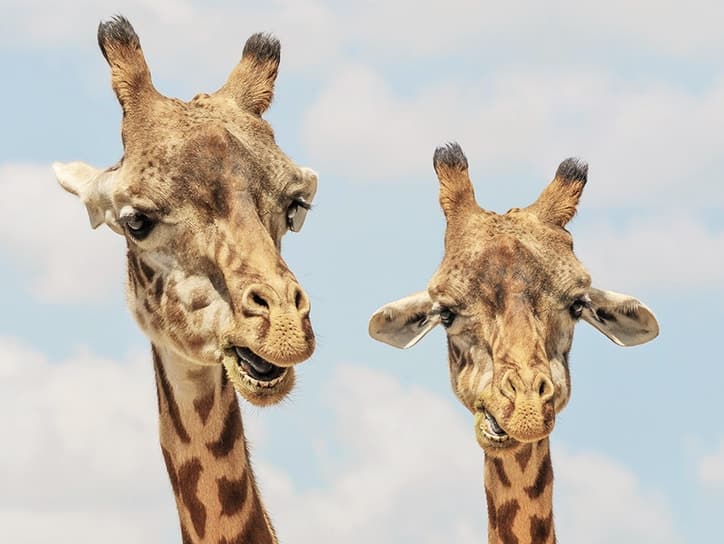Here, I offer ten amazing facts about animals that should affect how we think about them and how we treat them.
1. God communicates with animals
This is the best explanation for the migration of the animals to Noah’s ark. In Genesis, God told Noah to build an ark in order to save himself, his family, and the land-dwelling creatures from the coming flood. However, he didn’t tell Noah to go out and round up the animals. He told him to bring them into the ark (Gen. 6:19), which meant to simply receive them. When it was time for the flood to begin, the text says the animals “went into the ark to Noah” (Gen. 7:9). The only explanation for the actions of the animals is that God drew them to the ark. God communicated with them directly, and they responded.
Another example of God communicating with animals can be found in the experience of the prophet Elijah. When Elijah fled from Ahab, king of Israel, he went to an area east of the Jordan River. The Bible says God commanded ravens to bring him food while he was there, and they did (1 Kings 17:4-6).
These examples don’t tell us that God is in regular communication with the animals, but they make clear that such communication has occurred. It is certainly plausible that God interacts with animals more than we realize.
2. God cares about the well-being of animals
We often quote Matthew 10:29-31 to emphasize God’s concern for humans. In this passage, Jesus helped his listeners grasp the extent of God’s concern for them: If God cares about the death of a common bird, he certainly cares about the needs of humans. That isn’t all we learn from this passage, however. Jesus also gave us insight into God’s attitude toward animals. True, humans are “more valuable” than a common little bird, but Jesus didn’t say that animals have no value to God. In comparison to humans, the little sparrow has little value, but God still values the life of that little sparrow enough to be moved by its death.
It isn’t just that God notices the sparrow’s death, like one might notice that the wind is blowing. Jesus wanted his listeners to understand that God is emotionally invested in that sparrow. He cares about what happens to it; he just cares more about what happens to people. Once we acknowledge that God is emotionally invested in birds, i.e., animals, as well as humans, we are now talking only about a difference in the degree to which he is, not whether or not he is.
The story of Jonah also offers insight into God’s concern for animals. After Jonah preached and the people of Nineveh repented, Jonah expressed his displeasure at God’s decision not to send destructive judgment on the people. In confronting Jonah about his hard-hearted attitude, God reminded Jonah that not only have 120,000 people been spared, “many animals” were also spared (Jonah 4:11). The well-being of these animals mattered to God.
In addition, Scripture teaches that God is personally involved in feeding the animals. Psalm 104:14 is instructive here. It says God “causes” the grass to grow for the cattle. The Hebrew text uses the causative form of the verb “to grow” to reveal this. God isn’t simply passively watching nature take care of its own. Verse 21 continues this theme when it says the young lions “seek their food from God.” Pulling these individual examples together, the psalmist speaks of animals in general, saying, “They all wait for You (God) to give them their food in due season” (v. 27).
3. God enjoys animals
In Psalm 104:31, the psalmist declared, “Let the Lord be glad in his works.” Clearly the statement speaks broadly of all that God has created, but it is preceded by a long description of God’s interaction with animals–wild goats, rock badgers, beasts of the forest, young lions, animals both small and great (see vv. 18-30). In a few more verses, the psalmist used this same word translated “glad” to describe his own joy in God. He said emphatically, “I shall be glad in the Lord” (Ps. 104:34).
It isn’t difficult to fathom that animals bring God joy when we consider the joy we get from watching our own children. We even enjoy watching animals with whom we have no creative connection. Given that, it is understandable that the one who created all things would enjoy them.
4. Animals reveal God’s sovereignty
When Job complained that God had mistreated him, God pointed to creation to help Job understand his sovereignty. Animals figure prominently in his response to Job’s attempted indictment. God reminded Job that it is he who provides for the animals (Job 38:39-41). He appointed them their place in creation (Job 39:6). God also pointed out that he is more powerful than the feared Behemoth and Leviathan by the very fact that he is their creator (Job 40:19; 41:10). While they may be beyond Job’s reach, they are not beyond God’s.
In response, Job acknowledged God’s sovereignty. He said, “I take back my words and repent in dust and ashes” (Job 42:6). The fact God used examples from the animal world to convince Job of his sovereignty suggests strongly that this is part of God’s intended purpose for his creation of animals. God has built wonder into animals, and by design, they point humanity to him as the great and only sovereign.
5. Animals bring glory and praise to God
In Psalm 148, the psalmist called on everything to praise the Lord. He included in this call sea monsters, beasts, cattle, creeping things and birds (vv. 7, 10). The final verse of the final psalm of the entire psalter reads: “Let everything that has breath praise the Lord. Praise the Lord!” (Ps. 150:6). Even though they don’t do so with words, animals still bring glory and praise to God.
By their very existence animals: (1) Point to God as creator. Animals are as much the product of God’s creative energy as any other part of creation. (2) Point to God as love. God loves life so much he creates it in seeming endless variety. (3) Point to God as designer. Animals fill a crucial part of the symbiotic relationship between all of creation. (4) Point to God as artist. Animals are a living display of the natural beauty God has built into creation.
6. Animals are reasoning creatures
Some deny that animals are capable of reasoning. They prefer to credit instinct for their decision making skills. They believe that animals are “as smart as they need to be” to survive. I believe this is simply not accurate. Animals are smarter than they need to be. I have witnessed my dogs on many occasions trying to communicate with me. They make up for their lack of language by finding other ways through their reasoning abilities to communicate their will.
In the Bible, God reveals animal intelligence through the unusual encounter of Balaam with his donkey (Num. 22:21-33). In that incident, the donkey saw the Angel of the Lord standing in the way and moved aside. Balaam became angry with the donkey because it wouldn’t obey him. Yet the Angel of the Lord credited the donkey’s quick thinking for Balaam’s deliverance. He declared, “The donkey saw me and turned aside from me these three times. If she had not turned aside from me, I would surely have killed you” (v. 33). The donkey recognized the danger and made a decision to get out of the way of the Angel, whom Balaam couldn’t even see.
Furthermore, we have all seen animals use tools to get food. They don’t need to use tools to eat. They have sources that don’t require the use of tools, but they have the reasoning capacity to know that a tool will help them get food. Also, we have all seen animals run from danger. How does an animal know it’s in danger? It must understand something about life in order to seek to protect itself. We credit reason for human responses to avoiding danger. Why wouldn’t we credit animals with reason when they do the same thing?
We cannot completely eliminate the concept of instinct as we think about animals, but at the same time, we shouldn’t rule out the evidence that animals are also capable of reason.
7. Animals may have a more acute awareness of spiritual reality than we realize
The incident of Balaam and his donkey brings into focus another insight about animals. It reveals that it is possible for animals to see angels (Num. 22:21-33). In that incident, Balaam was spared death at the hands of the Angel of the Lord because Balaam’s donkey “turned aside” when it saw the angel. The text does not say the Angel of the Lord revealed his presence to the donkey. It tells us simply that the donkey saw the Angel.
Humans see angels when the angels want to reveal themselves. The donkey saw the Angel of the Lord without his self-revelation. In fact, judging from the Angel’s comments to Balaam (see v. 33), the donkey was actually acting contrary to the Angel’s intentions. We could understand it if the Angel said he wanted the donkey to help Balaam avoid the fate he had planned for him. But the text does not say that. A plain reading of the text suggests that the donkey was actually frustrating the plan of the Angel. The donkey saw the Angel without the Angel’s assistance.
This conclusion gains further support when we see that the Lord had to empower the donkey to speak (v. 28). If Moses recognized the need to tell the reader the Lord empowered the donkey to speak, he could just as easily have said the Lord enabled the donkey to see the Angel of the Lord. Yet, he doesn’t tell us that.
While we should not attempt to develop a major doctrine around this single event, it still raises significant questions about our understanding of the relationship of animals to the spiritual world.
8. Animals have the capacity to enjoy life
The psalmist was lighthearted when he described the joy animals feel. In Psalm 104, he said God formed the sea creature Leviathan “to play” in the sea (v. 26). The Hebrew word translated “play” occurs fairly regularly in Scripture. King David used this word to describe his celebration as the ark of God was being brought to Jerusalem (2 Samuel 6:21). He was ecstatic. The psalmist said this beast of the sea can also be ecstatic.
The book of Job supplies additional insight. There, God, himself, described the joy animals experience. He mentioned the ostrich flapping its wings “joyously” (Job 39:13), and the beasts of the field “playing” in their surroundings (Job 40:20).
This isn’t some foreign concept to us. We have all seen animals playing. The testimony of Scripture and our own experience remind us that animals are more than automatons driven by instinct. They are beings with the capacity for joy.
9. Animals teach us about the nature of justice
In Robert Bolt’s play, A Man for All Seasons, Sir Thomas More delivers a brilliant summation of God’s purpose for creating the angels, animals, plants, and humanity. Regarding animals, he observes God created them “for their innocence.” It is difficult to find a better description of animals than this. Animals appear to lack the capacity for moral reflection. They simply do what they do. Scripture supports this understanding. It was humans who ate from the tree of the knowledge of good and evil, not animals (Gen. 3:1-7).
This observation of animal innocence is not only important for our understanding of animals. It also helps us understand our sense of justice. When we ask why we are offended by cruelty to animals, we recognize we are reacting to an innate sense within us that is repulsed by wanton violations of their innocence and vulnerability. This recognition helps us understand some of our motivations for our criminal justice system. When we punish acts of aggression against our fellow humans, we are responding to violations of their innocence and vulnerability. Such violations should be punished. Our sense of justice demands it.
Furthermore, we learn about divine justice from animals. Israel’s biblically mandated practice of substitutionary atonement provides this lesson. Scripture teaches that rebellion against God is sin. God’s holiness demands a penalty in response to this rebellion. In other words, God requires justice. Either the guilty person or an acceptable substitute must answer for human sin. God created the sacrificial system in Israel to help his people understand this reality. He commanded that this system regularly kill innocent animals in order to satisfy the demands of his divine justice (Lev. 16:1-34). The innocent animals would bear the sin of the people. This bloody display served as a symbol for what was yet to come–when the innocent Son of God would offer himself as the true, eternal, substitutionary sacrifice for the sin of all humanity (Rom. 3:21-26; 2 Cor. 5:21; Heb. 10:1-18).
10. Animals belong to God
Psalm 24:1 states without reservation–“The earth is the Lord’s, and all it contains.” This fact is repeated regularly in Scripture. While God commanded the first man and woman to “rule over” every living thing (Gen. 1:26), He was not relinquishing ownership of every living thing.
In fact, God did not relinquish ownership of anything (Col. 1:16; Rom. 11:36; Heb. 2:10). He put the man and the woman in the Garden to “cultivate it and keep it” (Gen. 2:15). He even gave humans authority over it, and after the Flood, he gave us all of the rest of creation for food. But none of this assignment of authority and power included a transfer of ownership. Humans serve a stewardship role toward creation, not an ownership role (Gen. 2:15). This stewardship pertains to everything and is intended to include an attitude of respect (Lev. 25:3-5; Num. 35:33). The animals are subject to humans, but they are not ours to do with as we will. They belong to God (Job 41:11; Ps. 50:10-11).
Conclusion
The reader will no doubt notice that most of my biblical references are from the Hebrew Scriptures. When one looks to the New Testament for evidence of the place of animals in God’s creation, there is less to work with. There are good reasons for this dearth. First, the New Testament is built on the revelation before it. It assumes the foundation of the Hebrew Scriptures. So, there is no need to repeat what has been previously stated. Unless the New Testament affirms that its teachings supplant the teachings of the Hebrew Scriptures, we are to accept their infallible guidance and truth as we do those of the New Testament. Second, the New Testament is dealing principally with the establishment of the church. The writings that comprise it are mostly related to the immediate demands of this endeavor.
Drawing from this entire biblical witness, we can make some important conclusions about how to think about animals. First, we must recognize that animals may very well be co-inheritors with us of the new creation. When we consider that animals were part of God’s original design for his creation, it is plausible that they are part of his eternal design, as well. In his letter to the church at Rome, the Apostle Paul said all of creation was subjected to the corrupting effects of the Fall and that the day is coming when it too shall be freed from this corruption (Rom. 8:18-22). There is no reason to suspect that animals are not part of this vision of a redeemed creation. The prophet Isaiah saw a day when humans and animals would live once again in perfect harmony (Is. 11:6-9). The Apostle Paul may be telling us this is a vision of eternity, not only of the millennium.
I’ll confess that I am not one who believes that animals go to heaven when they die. I don’t see any biblical evidence for this. But given these statements from Isaiah and Paul, we should give more consideration to the place of animals in eternity. They may not be the same animals we have come to love in our lifetimes, but it seems they have a future beyond the Fall. Whether we are talking only about the millennium or about all of eternity, animals deserve to be treated with the dignity such a future bestows.
Second, we must lose some of our anthropocentric view of creation and replace it with a theocentric view, where God is engaged with all of creation, not only humanity. While a theocentric view of creation should not cause us to equate humans with the rest of creation, it should cause us to treat the rest of creation with more respect. God is interested in all of creation, not only humans. After the Flood, he covenanted with all flesh on the earth, including the animals, never again to destroy the earth with a flood (Gen. 9:11-17). The fact that God would enter into a covenant with the animals tells us something of his love for them. We, therefore, should be more concerned about all of creation, including animals, too.
Third, these biblical truths about animals mean we should be engaged in activities that help the rest of creation fulfill God’s design and interest in it. Possibly, we don’t know all that means. For example, who would have guessed that God would use the ravens to feed his prophet? He might very well be doing similar things in some part of the world today. Consequently, we should help to empower creation, not as its slaves or its equals, but as its caretakers.
Fourth, we must abandon unbiblical notions about animals and embrace a more biblical view of our animal co-inhabitants. The Bible compels us to develop a better appreciation and respect for them. I’m glad science is revealing many enlightening truths about the animal world. But it is clear that Scripture has already revealed much of what science is discovering. Animals are much more complex than they at first appear to be. We should do all we can to better understand them and their place in God’s creation. It will not only be good for them, but us as well.
God put animals on the planet and gave them a mandate as well. Part of the human calling is to help them fulfill this mandate in a way that enables them to reach their full potential in creation. They not only enrich our lives. They point to the creator of all things. Animals are not only worthy of our respect. They deserve it.










